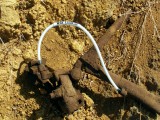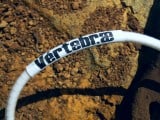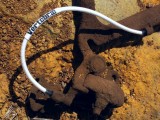 |
On the other hand, the intact sections are made of three different materials which have withstood all forms of weathering and chemical degradation. These warrant much closer inspection:1) The segmented pieces have an exquisite alumina-ceramic construction. This shows one of the highest stiffness to weight ratios of any currently known material. Second only in hardness to diamond, these segments show very minimal signs of wear due to mechanical friction, but it is only evident when examined by atomic force microscopy. Obviously whoever (or whatever) designed this were able to devise a way of purifying aluminium oxide (also known as sapphire) in order to form this extremely inert material, then create structural parts using hitherto unknown processes. They have cleverly turned nature against itself so to speak; aluminium oxide is one of the most abundant compounds contained within the Earth’s crust and also one of the most chemically stable. Ironically, the fossilised parts also have a similar final composition (bauxite, a mineral containing aluminium oxide) but this decomposition was purely unintentional.2) The interior tubing is made of an inert polymeric material, polytetrafluoroethylene and it still maintains a low coefficient of friction. Note that this is not a traditional Teflon coating but rather a solid form of the plastic.3) The outer sleeve is made from fluorinated ethylene-propylene. The slightly faded inscription can still be read, bearing the curious name: “Vértebr.æ”. One could surmise that mind in charge of ink deposition was not of the same standard as the others. Another hypothesis is that this is merely a prototype, a sign of things to come.In conclusion, we already knew that this civilisation at least had knowledge of primitive metallurgy, but these findings reveal a novel approach to material selection, industrial design and mechanical engineering. We can’t say how or indeed why this mechanism was created, yet one thing remains clear – it was fabricated by two quite distinct technologies and/or philosophies, the one called “Vértebr.æ” far more advanced than the other. Finally a product appears that is truly designed to last the ages. Perhaps these beings, cursed by their own ignorance, deserve further investigation… |




